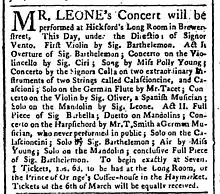Gabriele Leone
Gabriele Leone (born Naples c. 1735 – 1790) was an Italian musician and composer who lived in Paris during the middle and later part of the 18th century.[1] A virtuoso on the violin and mandolin, he wrote an early mandolin method, Analytical method for mastering the violin or the mandolin in 1768 and composed for both instruments.[1][2] He was an early teacher of the duo method, an advanced technique which would reappear in the 20th century, taught by Giuseppe Pettine in the United States.[3]

In the 1700s, the mandolin spread across Europe for the first time, through performances by masters of the instrument.[3] Leone was one of those early masters who spread the mandolin in Europe, giving concerts and teaching.[3] He spent time in London (1762–1763) as director of the London Opera before returning to Paris where he performed at the Concert Spirituel from 1760 to 1766.[3][4] One of his students was Louis Philippe II, Duke of Orléans, the father of King Louis Philippe I (the last French king).[3][4]
Leone was born in Naples about 1835. While he was a boy, what we now call the Neapolitan mandolin was being perfected by the Vinnaccia family, about 1844–1850. That Leone played and taught the Neapolitan mandolin is confirmed by his mandolin method, which shows a picture of the 8-stringed instrument and its tuning.
Works

He referred to himself on the covers of his works as Mr Leone de Naple (Monsieur Leone of Naples).[1]

His mandolin method was meant to help students of the violin switch to the mandolin, "from bow to feather" without the need for a teacher, using sheet music marked with "conventional signs" to guide learners.[5] Feathers were used as plectrums in that era, as they had been when playing the mandore. The method contained 26 dancing tunes, 6 minuets, 2 duos, a sonata and some airs.[1]
Books
- 1768, Paris, Méthode raisonnée pour passer du Violon à la Mandoline (Analytical method for mastering the violin or the mandolin)[1]
Music
- 1767, Paris, 6 Sonates pour mandoline et basse continue, Livre 1 opus 1 (6 Sonatas for mandolin and basso continuo, Book 1 opus 1)[1]
- 1770, Paris and Lyon, Six sonates de mandoline et basse marquées des signes suivant la nouvelle méthode opus 2 (Six sonatas of mandolin and bass marked with signs according to the new method opus 2)[1]
- 1772, Paris, [6] Duo pour deux violons qui peuvent se jouer sur la mandoline et sur le par-dessus [de viole] (6 Duets for two violins that can be played on the mandolin and descant [viol])[1]
Recordings
- 2015 Leone: Six sonates pour la mandoline et basse, Livre I, played by Maria Lucia Barros, Florentino Calvo, Ana Yepes[6]
References
- Joachim (19 August 2006). "Gabriele LEONE (1725–1790)". musiqueclassique.forumpro.fr. Retrieved 25 April 2019.
- Bone, Philip James (1914). The guitar and mandolin : biographies of celebrated players and composers for these instruments. London: Schott. p. 182.
Leone, a French musician who lived in Paris during the middle and latter part of the eighteenth century. He was a violinist and mandolinist , and is known as the author of a volume which was published in Paris in 1770, entitled Analytical method for mastering the violin or the mandolin.
- "Festival International de Mandoline de Castellar Du 17 au juillet 2019". festivalmandoline.fr. Retrieved 25 April 2019.
- "Gabriele LEONE". ensemble-gabriele-leone.org. Retrieved 25 April 2019.
- joachim (19 August 2006). "Gabriele LEONE (1725–1790)". musiqueclassique.forumpro.fr. Retrieved 25 April 2019.
Methode raisonnee pour passer du violon a la mandoline et de l'archet a la plume, ou Le moyen seur de jouer sans maitre en peu de temps par des signes de convention assortis a des exemples de musique facile. [Translation: Method reasoned to pass from the violin to the mandolin and the bow to the feather, or the means of playing without master in a short time by signs of convention matched with examples of easy music.]
- "Leone: Six sonates pour la mandoline et basse, Livre I". play.google.com. Retrieved 14 June 2019.
[Arion records, 2015]